By Puteri Balkish
At the roadside or by the sidewalks, we would normally spot a mak cik selling an assortment of traditional Malay kuih like akok, koci, karipap and apam.
During other times, we would catch a sight of an auntie next to her white coloured lorry selling soya bean and tau fu fa. On another occasion, hearing œPutumayam, putumayam¦. at the sight of an uncle on his motorcycle seems to already be a norm for us.
However, how often do we think of the delicacies and dishes in Sarawak, besides their mee kolok and kek lapis Sarawak, or Sabah, besides their batang buruk? What else do we actually know about Borneo?
Besides Malays, Chinese and Indians, we tend to forget that there are more ethnic groups and indigenous people in our country, especially in East Malaysia. Unity in diversity is constantly spoken of, but are we really practicing it, or those words are merely paying lip service?
Since the celebrations of Malaysia Day on September 16 was declared, the celebration of Merdeka Day does not run far from the celebration of Malaysia Day, but are we really paying attention to the distinct meanings of these vital occasions?
In order for one to comprehend the meaning of Malaysia Day, one must first appreciate Merdeka Day. On the eve of Merdeka, Amirah Adlina and her bestfriend, Qistina Mazlan, decided to pose with the Jalur Gemilang on the peak of Trolltunga (trolls tongue), a rock formation 1100 metres above sea level in Norway as a symbol of appreciation towards our motherland.
œThe whining and exhaustion melted away when we witnessed the surreal view, I suppose this is similar to the feelings attained during the achievement of the countrys Independence, Amirah said as she reminisced the strenuous ten-hour climb.
œThe effort to reach euphoria would be filled with struggle but the end result would be a big relief, she added as she went on about the Merdeka celebration.
Talking about victorious moments in our motherland, besides the recent overall win in the 2017 SEA Games, Malaysia was also the host during the 1989 SEA Games on 31 August.
Dollah Salleh and Lim Teong Kim secured the mother of the gold medals after a decade of waiting. Truly, it was a priceless moment for Malaysian football back then.
Based on historial records, the formation of Malaysia as a country began on 16 September 1963, with the inclusion of Sabah, Sarawak and Singapore whereas the Merdeka Day celebration is to commemorate the sacrifices made by past warriors for our countrys independence.
In terms of inclusiveness, many perceive that Peninsular Malaysia is the centre of attention at the first thought of Malaysia. Malaya is made of more than just the Malays, Chinese and Indian people, but without realising it, why do we exclude the others due to our selfishness and big-headedness?
Some of our own people are still pointing out the visible barrier between people of West and East Malaysia.
œPeople in Peninsular Malaysia still perceive Sabah and Sarawak as backwards and outdated when in truth, we are equally as modern as other states in the mainland, A Malay-Muslim Sabahan, Luqman Hakim said.
A Bidayuh-Christian Sarawakian, Courteney Celine said, œAs Sarawakians, we are always asked if we still lived on trees and the Orang Asli are still seen as uneducated. She has also encountered people saying that Sarawakians should be a separated entity from Malaysia because of their Borneo origin.
In this millennium, there are still misconceptions by our own people towards one of our own, as we tend to come up with conclusions in our heads as to what they really are when in fact, they are beyond what the society perceives.
As a Kadazan-Chinese Muslim, Nurlina Kuo Abdullah sees Malaysia Day as remembering Peninsular and East Malaysia as a combination with 14 united members under a roof.
œWe should begin by understanding their language, trying out their dishes, learning their beliefs and most essentially, maintaining respect, she added.
Nurlina also mentioned that she gets to enjoy a ˜dual citizenship as she gets to celebrate Chinese New Year as well as Kaamatan Day annually.
Dayang Umira, from the Land of the Hornbill suggested that the government should also include Kadazans and Ibans as part of the main races in Malaysia as they are the most prominent ones in Sabah and Sarawak.
Instead of three, she proposed for the government to consider five instead.
œI feel that Malaysia Day should have an even bigger celebration than Merdeka, she added.
Mikhail Hasanudin, a Malay-Chinese Muslim from the Peninsular said, œThe government should organise more cultural events to promote the Borneo culture as the existing ones are not enough to educate the public.
He also mentioned, œThe segregation for students from Sabah and Sarawak should be equal in public universities around Malaysia.
On this particular Malaysia Day, we should try to truly leverage on our cultural and ethnic diversities and strive to live harmoniously in our melting pot of cultures without excluding our own people. We should take pride of our identity as Malaysians “ regardless of being different in colour, blood, religion or dialect.***
